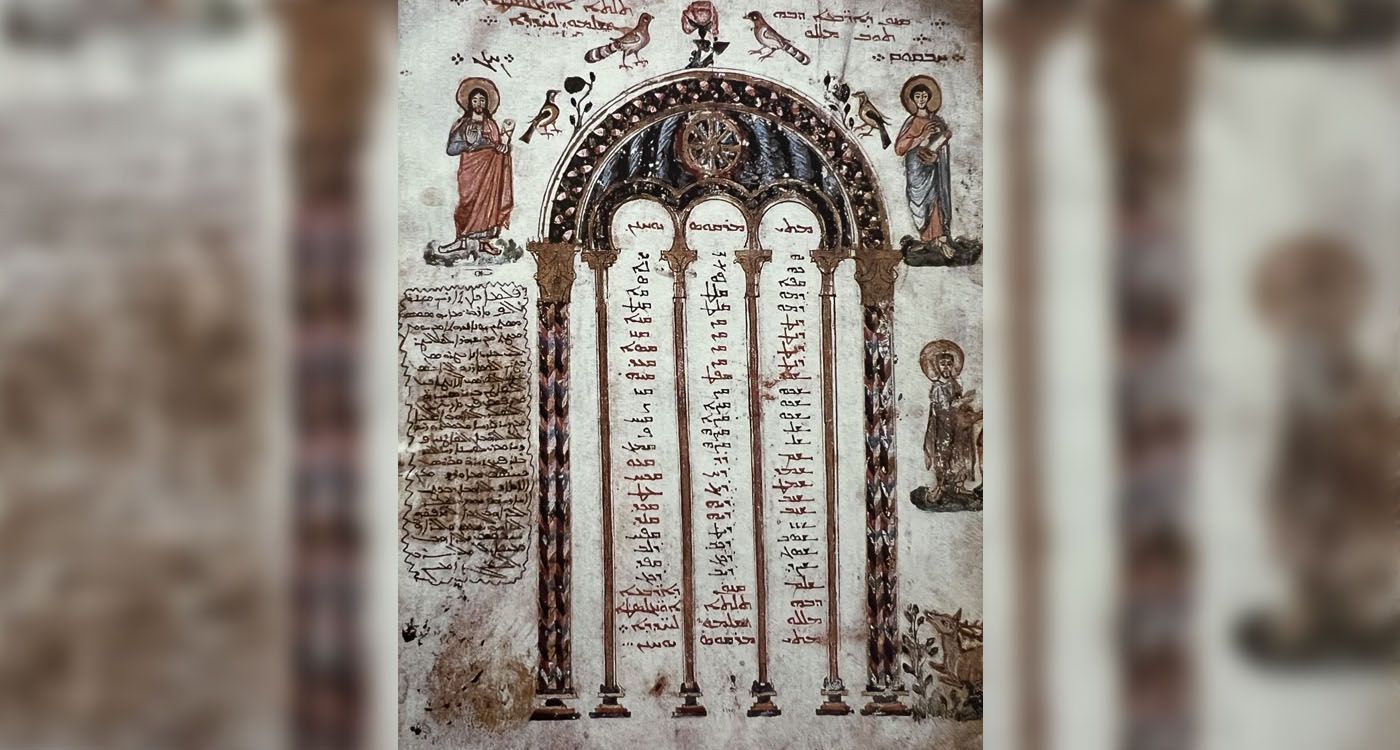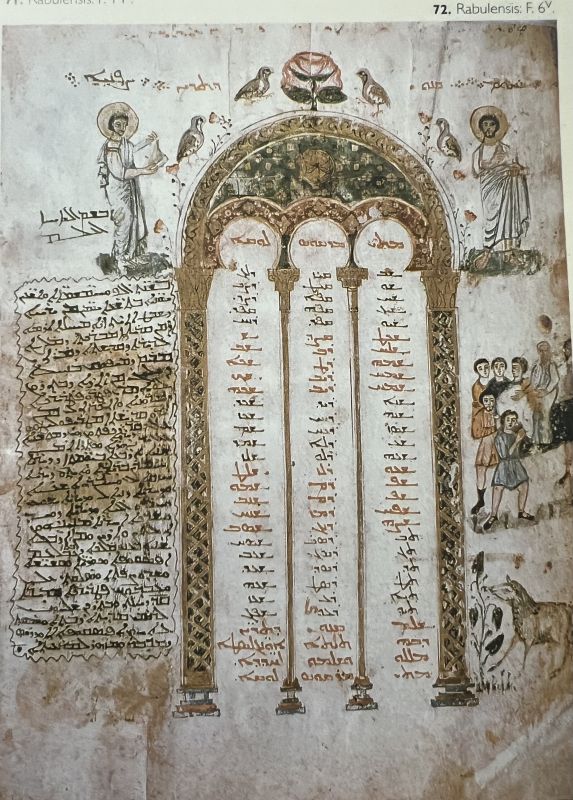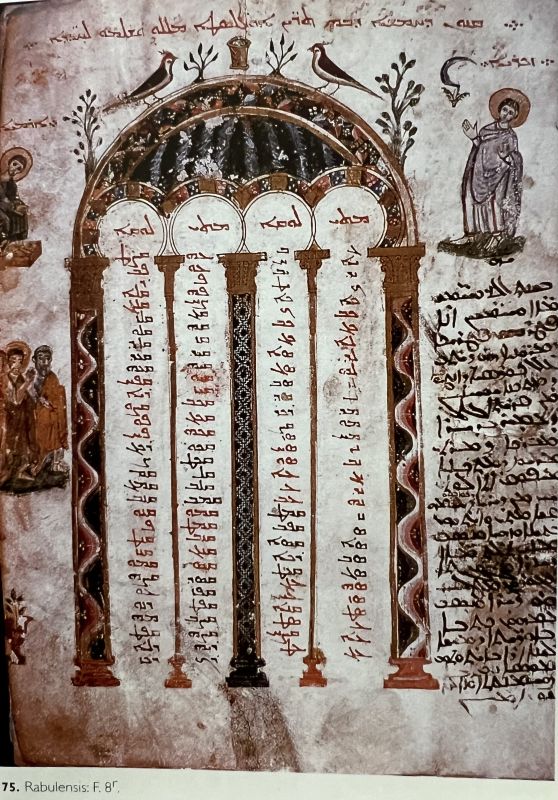
Written in the year 586, the Codex Rabulensis features annotations by Maronite patriarchs spanning from the 13th to the 15th century. Some are purely explanatory, serving as captions for illustrations, while others range from minor donations of olive oil to accounts of major historical events.
The Codex Rabulensis is a manuscript rich in history, similar to the layered strata of an archaeological site. Written in the year 586, it features annotations by Maronite patriarchs spanning from the 13th to the 15th century. Figures such as Daniel III of Hadshit (1278–1282) and Simeon V of Hadat (1492–1524), along with bishops and humble scribes, inscribed their writings onto the folios of this renowned Syriac gospel.
The Era System
Like the monk Rabula, who marked the colophon with the month of Shvot (February) in the year 897 of Alexander (586 AD), the Maronite patriarchs of Ilige and later Qannoubine also adopted the Antiochene era. Rooted in the Antiochene tradition, the Maronite Church identifies with this city and, by extension, the Seleucid era, which began in 311–312 BC. This somewhat arbitrary starting point was set in 305 BC by Seleucus following his reclaiming of Babylon. All Maronite chronological records adhered to this system until the transition to the Gregorian Christian calendar with the establishment of the Maronite College in Rome in 1584.
Unlike other Christians in the East, the Maronites did not use the Hijri era, which was often mentioned by the Jacobite Syriacs and the Nestorians, who referred to it as Tayoyé. Before 1584, the Maronites used the Seleucid era, sometimes referred to as D’Alexandros (of Alexander) or D’Yawnoyé (of the Greeks). After this date, they began using the Christian era, which they recorded as da Mchiho (of Christ), Mchihoyto (Christian), or Kristionto.
The Marginal Notes
The interventions of the Maronite patriarchs are primarily found on the painted folios, in the margins of the Canons of Concordance. Some are purely explanatory, serving as captions for illustrations, while others range from the most trivial donations of olive oil to the most significant historical events.
These accurately dated texts mention the patriarchs Daniel III of Hadshit (1278–1282), Jeremiah III of Dmalça (1282–1297), Jean XI of Gége (1404–1445), Jacques III of Hadat (1445, 1468), Pierre VI of Hadat (1468–1492), and Siméon V of Hadat (1492–1524).
Folio 2 R°
On folio 2 recto, which presents Ammonius of Alexandria and Eusebius of Caesarea, their names are inscribed in red in estranghelo square script: Amonios Alexandroio and Ousebios Qosroio. However, at the bottom of the folio, a later inscription appears in black ink and serto cursive script. This text in Garshouné was added in the 15th century at the patriarchal monastery of Qannoubine. Dated according to the Greek era, it reads:
On the date of the year 1771 (1460 AD), the wife of the Mqadam (chief) Qamar (...), may Almighty God protect them, Amen, this blessed woman donated to the monastery of Qannoubine, from her own money and property, the sum of 800 ducats.
Folio 14 R°
Folio 14 recto depicts Christ enthroned. Its inscription, likely added at the end of the 14th century, is unreadable, as it was scraped off by the knife of a bookbinder. The text, a mix of Syriac and Garshouné, retains only the beginning of each line:
(In the name) of God the Eternal (...) on the day of the feast of the Synod, in the month of (...) Georges from the Village of Kfar (...) olives (…) bequeathed (...) seventy-five olive saplings (...) from the village (...) and there was (...) one thousand seven hundred ten (...) of Iskandar (Alexander) the Greek (circa 1398–1399 AD) (...) son of (...) from the village of Bsharré (...) the priest Sarguis from the village of Hadshit (...) the priest Moussa (Moses) from the village of Bqoupha (...) the humble (miserable) among the clergy (...) in the name of a priest from the village of Hadshit.
May God have mercy on (...) in this bequest ...
Folio 6 V°
The triple arch on folio 6 verso represents the Second Canon. Its illustration in the left margin, beneath Sophonias, was erased to make room for the text of Patriarch Jeremiah of Dmalça (1282 and 1297), ally and protector of Bohemond VII, Count of Tripoli. Caught in internal conflicts with his cousins from Gibelet (Byblos), the Count was in great need of the Maronite Church’s protection. To ensure its intercession on his behalf in Rome, Bohemond VII used his influence to have Jeremiah elected to the patriarchal see. This is what the Syriac text, written in estranghelo characters, reveals:

In the year 1590 of the Greeks (1279 AD), on the 9th of the month of Shvot (February), I, the humble Jeremiah from the blessed village of Dmalça, came to the monastery of Our Lady Saint Mary of Mayphouq, in the valley of Ilige, in the land of Botroun, to Mor Petros, Patriarch of the Maronites. I was ordained by his holy hands as Metropolitan of the monastery of Kaphtoun, which is located by the river. I stayed there for some time; at that time, monks lived in the monastery. They were Ezekiel, John, Monk Daniel, Monk Isaiah, Monk Joshua... and Elias, Monk David, and the others, a total of thirty-two. After four years, the king (Bohemond VII) of Gibelet (Byblos), along with the bishops, archpriests, and hieromonks, summoned me and cast lots. It fell on me, and I was made Patriarch at the holy monastery of Halat. Then I was sent to the great city of Rome, leaving our brother, Bishop Theodore, to administer and shepherd the flock.
Folio 7 V°
The Fourth Canon on folio 7 verso also features a triple-arched composition. In the middle of the left margin, the scene was erased to make room for the text of Patriarch Peter III, who chose to write in cursive serto script. He wrote the text in Garshouné:
In the year 1465 of the Greeks (1154 AD), on the 8th of the month of Ilûl (September), the young monk Isaiah from the monastery of Qozhaya came to me, Peter, Patriarch of the Maronites, seated on the throne of Antioch at the convent of Our Lady of Mayphouq in the Valley of Ilige. I appointed him as the superior of the monks of the convent of Saint John of Kûzvandû on the island of Cyprus, in accordance with the letter he brought me, written by the monks Gabriel, his companion Simon, the monk Habakkuk, and the monk Michael. To God be the glory, Amen.
Folio 12 R°
The Tenth Canon on folio 12 recto, framed by a triple arch, illustrates Judas’s betrayal in the right margin and his suicide in the left. A later Maronite note added a caption in Syriac, written in serto script, which states:
Judas Iscariot went and bought a rope, then hanged himself from a fig tree.
Folio 8 R°
On folio 8 recto, the Fifth Canon features a composition with four arches. The text on the right, written in Syriac, is attributed to Patriarch John VIII. His handwriting—or that of his scribe—is skillfully executed in serto script. It reads:
In the year 1550 (1239 AD), I, Petros (Peter being the patriarchal title), Patriarch of the Maronites, seated on the throne of Antioch and known as John from the village of Géjé, residing in the blessed monastery of Our Lady of Mayphouq, was visited by my brother from the monastery of Kûzvandû (Cyprus), named Qaso Mataï (Hieromonk Matthew), a venerable and chaste man. From me, he received three hundred dinars and a vial of Myron (Holy Chrism) for the monastery. He also took with him a book of the Mosaic Law (...), along with the Law and the Book of Faith. To God be the glory, Amen.

Folio 11 V°
The Tenth Canon contains passages from the New Testament that are reported only by Saint Mark. Therefore, it requires just one numerical list for citation. This explains its single-arched composition, found on folio 11 verso.
The small inscription on the left refers to a basin donated to the monastery. The narrative is expanded in the inscription on the right and in the text, which is divided into two columns under the arch. It is written in Garshouné:
In the year 1772 of the Greeks (1461 AD), Archpriest Georges and Archpriest Hilel, who resided at the Hawqa Monastery, donated a large basin to the blessed Monastery of Qannoubine, as an endowment through their work and efforts, leaving it as a memorial of their part in this world and in the hereafter. May God bless them. Amen. (...) Thus, this donation was fulfilled during the time of our father, master, leader, crown, and administrator, Patriarch Mar Jacques, may God bless him, and may he bless us by the grace of God. Amen.
Page of Text
Maronite notes are also found throughout the pages of text, often in the margins, and typically concern acts of donation. However, they indirectly hold historical value by referencing notable figures of the period. One such note, from the early 16th century, mentions Pope Leo X, Patriarch Peter VI of Hadat, Monk Francis of Jerusalem, and Mqadam (chief) Joseph.
In the year 1827 of the Greeks (1516 AD), the Pope of Rome (Leo X) sent to Patriarch Peter, son of David, known as the Son of Hassan (Peter VI), from the village of Hadat, through Monk Francis, Superior of Jerusalem and his interpreter, an altar cloth and an embroidered glove (...), gold-embroidered liturgical garments (...), a chasuble embroidered in gold and silver, two embroidered chapes, and a mitre inlaid with pearls, three robes made of cloth, two others for Elias, son of Mqadam (chief) Joseph, and ten robes made of cloth for the monks of the convent.





Comments